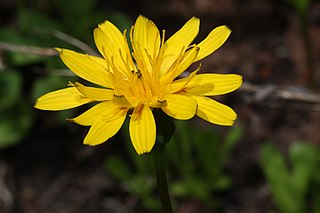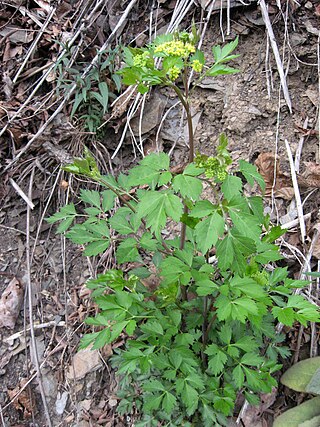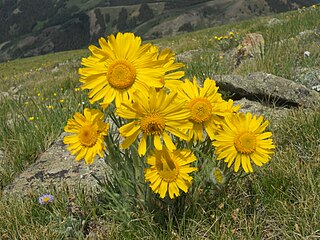
The Red Rock Canyon National Conservation Area in Clark County, Nevada, United States, is an area managed by the Bureau of Land Management as part of its National Landscape Conservation System, and protected as a National Conservation Area. It is about 15 miles (24 km) west of Las Vegas. More than three million people visit the area each year.

Coreopsis is a genus of flowering plants in the family Asteraceae. Common names include calliopsis and tickseed, a name shared with various other plants.

Toxicodendron diversilobum, commonly named Pacific poison oak or western poison oak, is a woody vine or shrub in the sumac family, Anacardiaceae. It is widely distributed in western North America, inhabiting conifer and mixed broadleaf forests, woodlands, grasslands, and chaparral biomes. Peak flowering occurs in May. Like other members of the genus Toxicodendron, T. diversilobum causes itching and allergic rashes in most people after contact by touch or smoke inhalation. Despite its name, it is not closely related to oaks, nor is it a true tree.
Calico is a plain-woven cotton textile.

Hesperocyparis bakeri, previously known Cupressus bakeri, with the common names Baker cypress, Modoc cypress, or Siskiyou cypress, is a rare species of western cypress tree endemic to a small area across far northern California and extreme southwestern Oregon, in the western United States.

Cornus racemosa, the northern swamp dogwood, gray dogwood, or panicle dogwood, is a shrubby plant native to southeastern Canada and the northeastern United States. It is a member of the dogwood genus Cornus and the family Cornaceae.

The Polemoniaceae are a family of flowering plants consisting of about 27 genera with 270–400 species of annuals and perennials native to the Northern Hemisphere and South America, with the center of diversity in western North America.

Langloisia is a genus of flowering plants in the family Polemoniaceae. It is monotypic, being represented by the single species Langloisia setosissima, also known as bristly langloisia, bristly-calico, Great Basin langloisia, and lilac sunbonnets. It is native to the western United States and north-western Mexico, where it is found in desert washes and on rocky slopes and plains from eastern Oregon and Idaho, south via Nevada and Utah to eastern California and Arizona.

Symphyotrichum lateriflorum is a species of flowering plant in the aster family (Asteraceae). Commonly known as calico aster, starved aster, and white woodland aster, it is native to eastern and central North America. It is a perennial and herbaceous plant that may reach heights up to 120 centimeters and widths up to 30 centimeters.
Galium matthewsii is a species of flowering plant in the coffee family known by the common names bushy bedstraw and Matthews' bedstraw. It is native to the mountains and deserts of southeastern California, and southern Nevada.

Loeseliastrum matthewsii is an annual herbaceous plant of the Polemoniaceae family known by the common name desert calico. It is native to the Mojave and Sonoran Deserts of western North America, where it is relatively common. It is a small plant with alternately arranged leaves, each up to 4 centimeters long and edged with bristle-tipped teeth. The flower is white, lavender, and purple streaked with a maroon arch over a white patch on each of the upper lobes.

Psilactis is a genus of North American and South American plants in the tribe Astereae within the family Asteraceae which are known by the common name tansyaster. There are six species within the genus.

Loeseliastrum schottii is a species of flowering plant in the phlox family known by the common name Schott's calico. It is native to the southwestern United States and northern Mexico, where it is common in many parts of the desert region. It is a small, hairy annual herb with alternately arranged leaves each up to 4 centimeters long and edged with long bristle-tipped teeth. The flower generally has three lobes on its upper lip and two on its lower. It is spotted to mottled in pattern, varying in color from purple-speckled white to orange-speckled yellow, sometimes with reds and pinks. The protruding stamens are curved and tipped with yellow anthers.

Diplacus pictus is a species of monkeyflower known by the common name calico monkeyflower.

Nothocalais is a genus of North American flowering plants in the tribe Cichorieae within the family Asteraceae. There are known generally as false dandelions or false agoseris.

Thaspium is a genus of flowering plants in the Apiaceae. A common name for the various Thaspium species is meadowparsnip or meadow-parsip. Its native range is eastern North America, from eastern Texas in the southwest to Maine in the northeast.

Sullivantia, commonly called coolwort, is a genus of flowering plants in the saxifrage family. It is a small genus, comprising only 3-4 species of perennial herbs all native to the northwestern and east-central United States. Sullivantia is most notable for having disjunct distributions primarily restricted to along the Pleistocene glacial margin. All species of Sullivantia are found on moist, often calcareous cliffs.
Hymenoxys brandegeei is a species of flowering plant in the daisy family known by the common names Brandegee's four-nerve daisy, Brandegee's rubberweed or western bitterweed. It is native to the states of Arizona, Colorado, and New Mexico in the southwestern United States.

Hymenoxys grandiflora is a North American species of flowering plant in the daisy family known by the common names graylocks four-nerve daisy, graylocks rubberweed, or old man of the mountain. It is native to high elevations in the Rocky Mountains of the western United States.
















